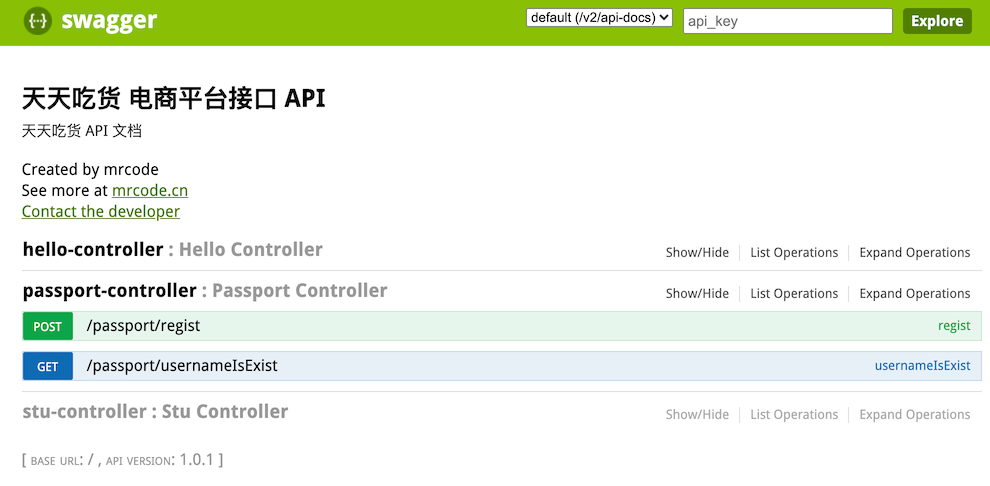# 整合 Swagger2 文档 Api
为了减少程序员撰写文档时间,提高生产力, Swagger2 应运而生,使用 Swagger2 可以减少编写过多的文档,只需要通过代码就能生成文档API,提供给前端人员
常方便。
引入依赖
<!-- swagger2 -->
<dependency>
<groupId>io.springfox</groupId>
<artifactId>springfox-swagger2</artifactId>
<version>2.4.0</version>
</dependency>
<dependency>
<groupId>io.springfox</groupId>
<artifactId>springfox-swagger-ui</artifactId>
<version>2.4.0</version>
</dependency>
<!-- swagger2 第三方 UI -->
<dependency>
<groupId>com.github.xiaoymin</groupId>
<artifactId>swagger-bootstrap-ui</artifactId>
<version>1.6</version>
</dependency>
1
2
3
4
5
6
7
8
9
10
11
12
13
14
15
16
17
2
3
4
5
6
7
8
9
10
11
12
13
14
15
16
17
swagger2 配置
package cn.mrcode.foodiedev.config;
import org.springframework.context.annotation.Bean;
import org.springframework.context.annotation.Configuration;
import org.springframework.web.servlet.config.annotation.ResourceHandlerRegistry;
import org.springframework.web.servlet.config.annotation.ViewControllerRegistry;
import org.springframework.web.servlet.config.annotation.WebMvcConfigurer;
import springfox.documentation.builders.ApiInfoBuilder;
import springfox.documentation.builders.PathSelectors;
import springfox.documentation.builders.RequestHandlerSelectors;
import springfox.documentation.service.ApiInfo;
import springfox.documentation.service.Contact;
import springfox.documentation.spi.DocumentationType;
import springfox.documentation.spring.web.plugins.Docket;
import springfox.documentation.swagger2.annotations.EnableSwagger2;
/**
* @author mrcode
* @date 2021/2/13 13:06
*/
@Configuration
@EnableSwagger2
public class Swagger2 {
// 原始 API 文档: http://localhost:8088/swagger-ui.html
// 第三方 API 文档:http://localhost:8088/doc.html
// 核心配置 docket
@Bean
public Docket createTestApi() {
return new Docket(DocumentationType.SWAGGER_2) // 指定 API 类型为 2
.apiInfo(apiInfo()) // 定义 API 文档汇总信息
.select()
.apis(RequestHandlerSelectors
.basePackage("cn.mrcode.foodiedev.api.controller")) // 指定 controller 包
.paths(PathSelectors.any()) // 该包中的所有 controller
.build();
}
private ApiInfo apiInfo() {
return new ApiInfoBuilder()
.title("天天吃货 电商平台接口 API") // 标题
.contact(new Contact("mrcode", "mrcode.cn", "api@mrcode.cn")) // 联系人信息
.description("天天吃货 API 文档") // 详细信息
.version("1.0.1") // 文档版本号
.termsOfServiceUrl("http://mrcode.cn") // 网站地址
.build();
}
}
1
2
3
4
5
6
7
8
9
10
11
12
13
14
15
16
17
18
19
20
21
22
23
24
25
26
27
28
29
30
31
32
33
34
35
36
37
38
39
40
41
42
43
44
45
46
47
48
2
3
4
5
6
7
8
9
10
11
12
13
14
15
16
17
18
19
20
21
22
23
24
25
26
27
28
29
30
31
32
33
34
35
36
37
38
39
40
41
42
43
44
45
46
47
48
原始 API 文档: http://localhost:8088/swagger-ui.html
原始的 UI 文档是由 springfox-swagger-ui 提供的

第三方 API 文档:http://localhost:8088/doc.html
第三方的 UI 文档是由 swagger-bootstrap-ui 提供的

# 优化 swagger 的显示
@ApiIgnore忽略显示,可以作用在类上、方法上、参数上比如上图中的 stu-controller 不显示,写在该 controller 类上即可
@ApiOperation:参数实体类描述@ApiModelProperty: 参数字段描述@ApiImplicitParams用于在没有实体对象封装参数的时候使用,比如@ApiImplicitParams({ @ApiImplicitParam(name = "username", value = "用户名") }) public JSONResult usernameIsExist(@RequestParam String username)1
2
3
4
优化完成之后的相关 controller 和 bo
@ApiModel(value = "用户对象 BO", description = "从客户端,由用户传入的数据封装在此")
public class UserBO {
@ApiModelProperty(value = "用户名", name = "username", example = "例如 admin", required = true)
private String username;
@ApiModelProperty("密码")
private String password;
@ApiModelProperty("确认密码")
private String confirmPassword;
1
2
3
4
5
6
7
8
9
2
3
4
5
6
7
8
9
package cn.mrcode.foodiedev.api.controller;
import cn.mrcode.foodiedev.common.util.JSONResult;
import cn.mrcode.foodiedev.pojo.Users;
import cn.mrcode.foodiedev.pojo.bo.UserBO;
import cn.mrcode.foodiedev.service.UserService;
import io.swagger.annotations.Api;
import io.swagger.annotations.ApiImplicitParam;
import io.swagger.annotations.ApiImplicitParams;
import io.swagger.annotations.ApiOperation;
import org.apache.commons.lang3.StringUtils;
import org.springframework.beans.factory.annotation.Autowired;
import org.springframework.http.HttpStatus;
import org.springframework.web.bind.annotation.*;
@Api(value = "注册登录", tags = {"用户注册登录的相关接口"}) // API 分组
@RestController
@RequestMapping("/passport")
public class PassportController {
@Autowired
private UserService userService;
@ApiOperation(value = "用户名是否存在", notes = "判断用户名是否存在", httpMethod = "GET")
@GetMapping("/usernameIsExist")
@ApiImplicitParams({
@ApiImplicitParam(name = "username", value = "用户名")
})
public JSONResult usernameIsExist(@RequestParam String username) {
// 1. 判断用户名不能为空
if (StringUtils.isBlank(username)) {
return JSONResult.errorMsg("用户名不能为空");
}
// 2. 查找注册的用户名是否存在
boolean isExist = userService.queryUsernameIsExist(username);
if (isExist) {
return JSONResult.errorMsg("用户名已存在");
}
// 3. 用户名没有重复
return JSONResult.ok();
}
@ApiOperation(value = "用户注册", notes = "用户用户注册", httpMethod = "POST")
@PostMapping("/regist")
public JSONResult regist(@RequestBody UserBO userBO) {
String username = userBO.getUsername();
String password = userBO.getPassword();
String confirmPassword = userBO.getConfirmPassword();
// 0. 判断用户名和密码必须不为空
if (StringUtils.isBlank(username) ||
StringUtils.isBlank(password) ||
StringUtils.isBlank(confirmPassword)) {
return JSONResult.errorMsg("用户名或密码不能为空");
}
// 1. 查询用户名是否存在
boolean isExist = userService.queryUsernameIsExist(username);
if (isExist) {
return JSONResult.errorMsg("用户名已经存在");
}
// 2. 密码长度不能少于 6 位
if (password.length() < 6) {
return JSONResult.errorMsg("密码长度不能少于 6");
}
// 3. 判断两次密码是否一致
if (!password.equals(confirmPassword)) {
return JSONResult.errorMsg("两次密码输入不一致");
}
// 4. 实现注册
Users user = userService.createUser(userBO);
return JSONResult.ok(user);
}
}
1
2
3
4
5
6
7
8
9
10
11
12
13
14
15
16
17
18
19
20
21
22
23
24
25
26
27
28
29
30
31
32
33
34
35
36
37
38
39
40
41
42
43
44
45
46
47
48
49
50
51
52
53
54
55
56
57
58
59
60
61
62
63
64
65
66
67
68
69
70
71
72
73
2
3
4
5
6
7
8
9
10
11
12
13
14
15
16
17
18
19
20
21
22
23
24
25
26
27
28
29
30
31
32
33
34
35
36
37
38
39
40
41
42
43
44
45
46
47
48
49
50
51
52
53
54
55
56
57
58
59
60
61
62
63
64
65
66
67
68
69
70
71
72
73